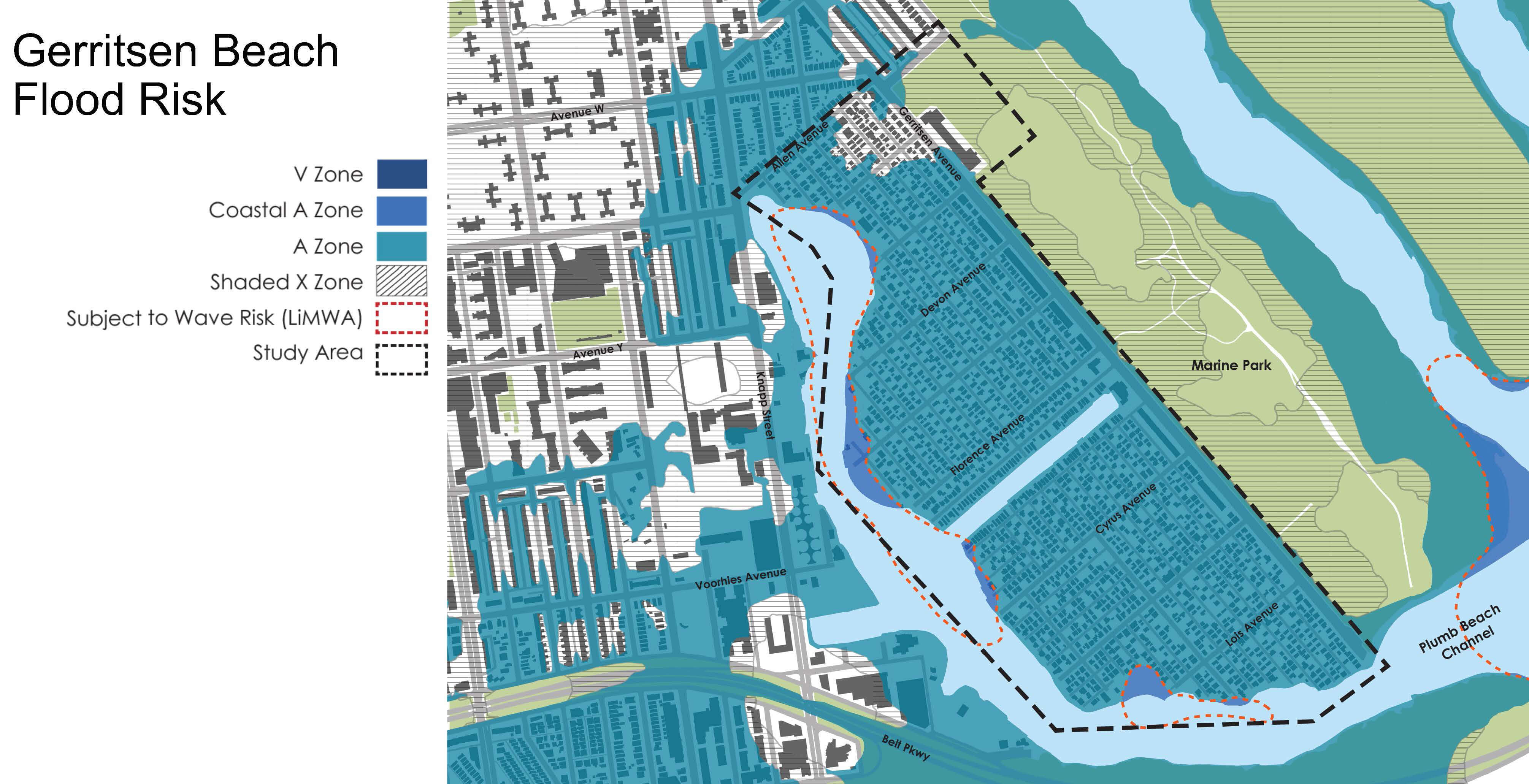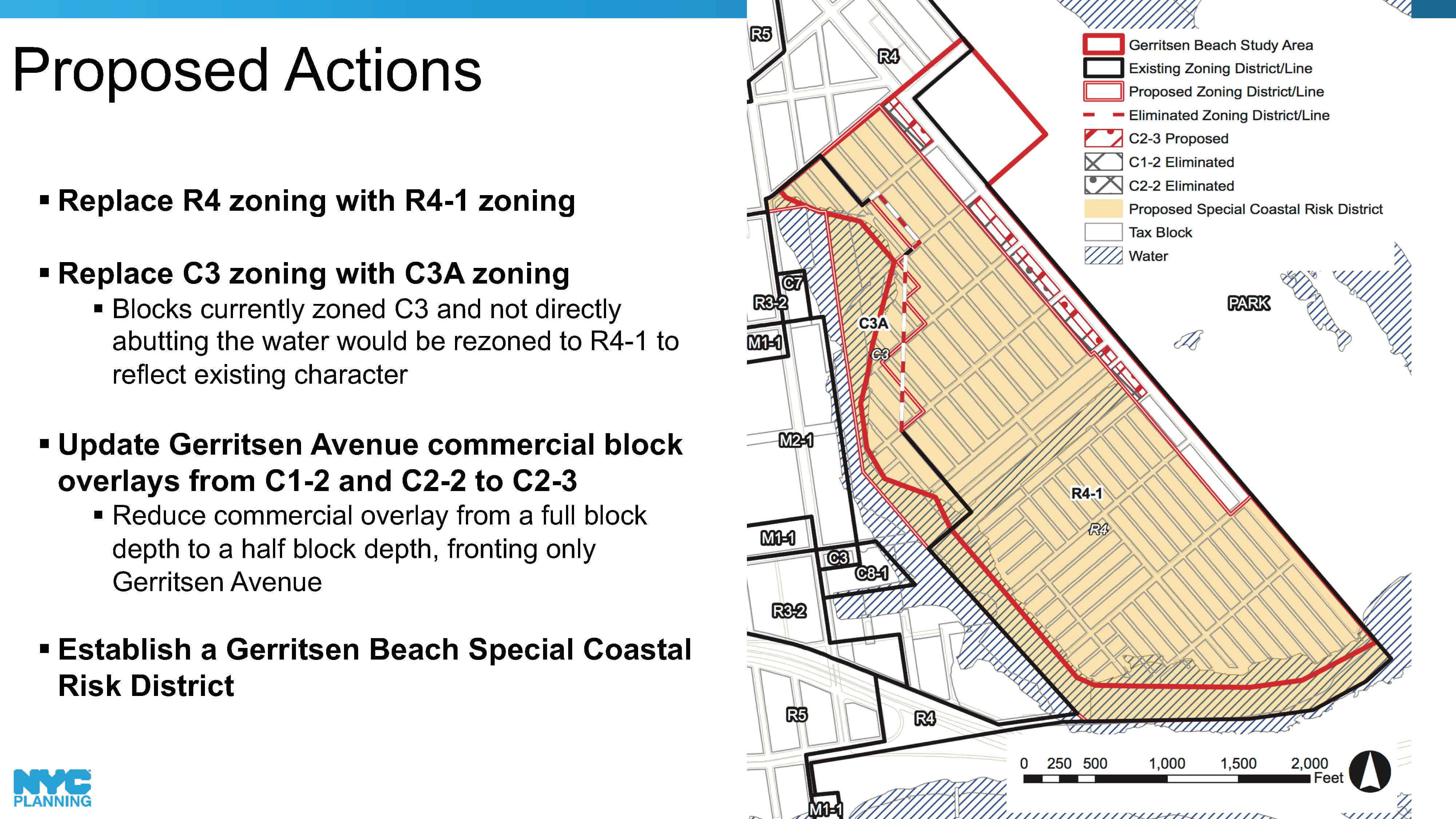Rezoning Proposed for Southern Brooklyn's Flood-Prone Coastal Neighborhoods
City Planning is proposing zoning measures in southern Brooklyn’s coastal neighborhoods that could help property owners protect their homes in flood-prone areas.

Photo via NYC Department of City Planning
City Planning is proposing a suite of new zoning measures in southern Brooklyn’s coastal neighborhoods that could help property owners protect their homes in flood-prone areas, while curbing the influx of newcomers to the low-lying zones.
The “Zoning for Coastal Flood Resiliency” plan aims “to help people living and working in the floodplain to reduce damage from future coastal flood events, to prepare to be resilient in the long term and potentially help save on flood insurance costs,” said Catie Ferrara Iannitto, a resiliency planner at the city department.
If approved, the new measures would ease building height limits when rising above the floodplain or when retrofitting non-compliant homes, while providing incentives to property owners to flood-proof ground floor spaces.
“We want to expand the relief so that homeowners are not as frequently faced with the challenge of ‘should I lose livable space in order to make my home resilient?’” Ferrara Iannitto said.
The proposal would cement and expand on temporary regulations implemented in 2013 after Superstorm Sandy, which sought to address onerous red tape that prevented property owners from improving a structure’s resiliency.
“The proposal now is to make many of those provisions that are in place now permanent,” the DCP rep said. “But also to expand them so that communities have even greater flexibility to adapt their buildings.”

While the current measures apply only to the city’s 1 percent annual chance floodplain — the highest-risk flood zone, which covers more than 165,000 Brooklynites — the DCP proposal would extend those flexibilities to the 0.2-percent annual chance floodplain, which is home to another 300,000 Brooklynites.
“With climate change, the floodplain is expected to continue to expand,” said Ferrara Iannitto. “So by the 2050s, today’s moderate risk zone will likely be at high risk for flooding,”
All flood-resilient construction is optional on structures within the moderate-risk zone, and is only required for new buildings or substantial redevelopment of existing structures in the most flood-prone zones — however, adapting a home or building for flood resilience can lead to significant reductions to a property owner’s flood insurance rate.
And on top of incentivizing homeowners to storm-proof properties, the new measures would simply prevent construction of new nursing homes in the most perilous floodplains all together — effectively limiting the amount of at-risk residents in areas where vehicular access can become difficult during extreme weather events.
“Nursing homes have populations that require continued medical care,” Ferrara Iannitto said. “And research has shown that that level of dependency can be strained whether nursing homes are asked to shelter in place or asked to evacuate prior to a coastal storm.”
Existing nursing homes within high-risk flood zones can expand under the proposed regulations by 15,000 square-feet in order to implement additional resiliency measures.
For public spaces in low-lying areas, the city planners’ proposal would provide new regulations aimed at weatherizing swaths of parks, plazas, and shorelines.
Specifically, department reps recommended added regulations for waterfront plazas in Sheepshead Bay and for the particularly dense and flood-susceptible neighborhood of Gerritsen Beach.

The Special Sheepshead Bay District, comprising both sides of Emmons Avenue between Sheepshead Bay Road and Knapp Street, was created in 1973 to promote maritime activities — but doesn’t currently include any requirements on resiliency in the area, which was particularly devastated by Hurricane Sandy.
“These rules were written before we were thinking about resilience,” said Kate Richard of the DCP’s Brooklyn office.
The Department’s proposal would prohibit new below-grade plazas, while consolidating existing floor area bonuses to promote more consistent open spaces and requiring plantings that improve resilience to floods.
“Some of these sunken plazas experienced pretty serious flooding during Sandy,” Richard said. “The proposed text change would encourage flood-resilient and active design in future Special Sheepshead Bay District open spaces by no longer allowing plazas to be located below grade.”
For neighboring Gerritsen Beach, DCP wants to establish the entire neighborhood as a “Special Coastal Risk District,” which will add additional regulations on top of the zoning amendments intended to reduce the neighborhood’s density.
Future construction in Gerritsen Beach would be limited to single- and two-family homes if the zoning amendments are approved, and homes will be restricted to 25 feet or two-stories above the ground floor.
“The purpose of those rules is to reduce the scale of potential future development in a neighborhood that is fairly vulnerable to coastal flooding,” said Richard.
Theresa Scavo, the head of local Community Board 15, applauded the proposed changes, saying they would enable many property owners to implement long-overdue resiliency improvements.
“I think it’s a good tool for people in Sheepshead Bay and Gerritsen Beach,” said Scavo. “For the residents of Gerritsen, this allows them to elevate their home and move their mechanicals from the ground floor…There are a lot of pluses to this project.”
The proposed downzoning of Gerritsen Beach is a particularly needed improvement, as rumors circle that a private developer is planning a possible five-family development across three adjacent lots in the neighborhood.
“I think it was needed, it is crowded, very congested,” Scavo said, adding that some residents hoped to see the rumored project stopped with new zoning laws.
City planners entered the prospective zoning changes and special proposals for Sheepshead Bay and Gerritsen Beach into public review on October 19.
Editor’s note: A version of this story originally ran in Brooklyn Paper. Click here to see the original story.
Related Stories
- Locals Get a Refresher Course, With Few Answers, About the Proposed Gowanus Rezoning
- Pols Charge Mayor Backs ‘Irresponsible Development’ Over Bushwick Community Plan
- Gowanus Residents Want to Halt Rezoning Until in-Person ULURP Meetings Can Resume
Sign up for amNY’s COVID-19 newsletter to stay up to date on the latest coronavirus news throughout New York City. Email tips@brownstoner.com with further comments, questions or tips. Follow Brownstoner on Twitter and Instagram, and like us on Facebook.





What's Your Take? Leave a Comment